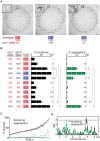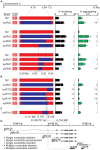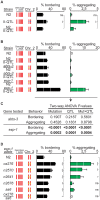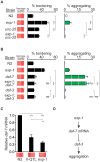Long-range regulatory polymorphisms affecting a GABA receptor constitute a quantitative trait locus (QTL) for social behavior in Caenorhabditis elegans
- PMID: 23284308
- PMCID: PMC3527333
- DOI: 10.1371/journal.pgen.1003157
Long-range regulatory polymorphisms affecting a GABA receptor constitute a quantitative trait locus (QTL) for social behavior in Caenorhabditis elegans
Abstract
Aggregation is a social behavior that varies between and within species, providing a model to study the genetic basis of behavioral diversity. In the nematode Caenorhabditis elegans, aggregation is regulated by environmental context and by two neuromodulatory pathways, one dependent on the neuropeptide receptor NPR-1 and one dependent on the TGF-β family protein DAF-7. To gain further insight into the genetic regulation of aggregation, we characterize natural variation underlying behavioral differences between two wild-type C. elegans strains, N2 and CB4856. Using quantitative genetic techniques, including a survey of chromosome substitution strains and QTL analysis of recombinant inbred lines, we identify three new QTLs affecting aggregation in addition to the two known N2 mutations in npr-1 and glb-5. Fine-mapping with near-isogenic lines localized one QTL, accounting for 5%-8% of the behavioral variance between N2 and CB4856, 3' to the transcript of the GABA neurotransmitter receptor gene exp-1. Quantitative complementation tests demonstrated that this QTL affects exp-1, identifying exp-1 and GABA signaling as new regulators of aggregation. exp-1 interacts genetically with the daf-7 TGF-β pathway, which integrates food availability and population density, and exp-1 mutations affect the level of daf-7 expression. Our results add to growing evidence that genetic variation affecting neurotransmitter receptor genes is a source of natural behavioral variation.
Conflict of interest statement
The authors have declared that no competing interests exist.
Figures




References
-
- Bendesky A, Bargmann CI (2011) Genetic contributions to behavioural diversity at the gene-environment interface. Nat Rev Genet 12: 809–820. - PubMed
-
- Flint J (2003) Analysis of quantitative trait loci that influence animal behavior. J Neurobiol 54: 46–77. - PubMed
-
- Mundy P, Sigman M, Ungerer J, Sherman T (1986) Defining the social deficits of autism: the contribution of non-verbal communication measures. J Child Psychol Psychiatry 27: 657–669. - PubMed
-
- Tandon R, Nasrallah HA, Keshavan MS (2009) Schizophrenia, “just the facts” 4. Clinical features and conceptualization. Schizophr Res 110: 1–23. - PubMed
Publication types
MeSH terms
Substances
Grants and funding
LinkOut - more resources
Full Text Sources
Miscellaneous

